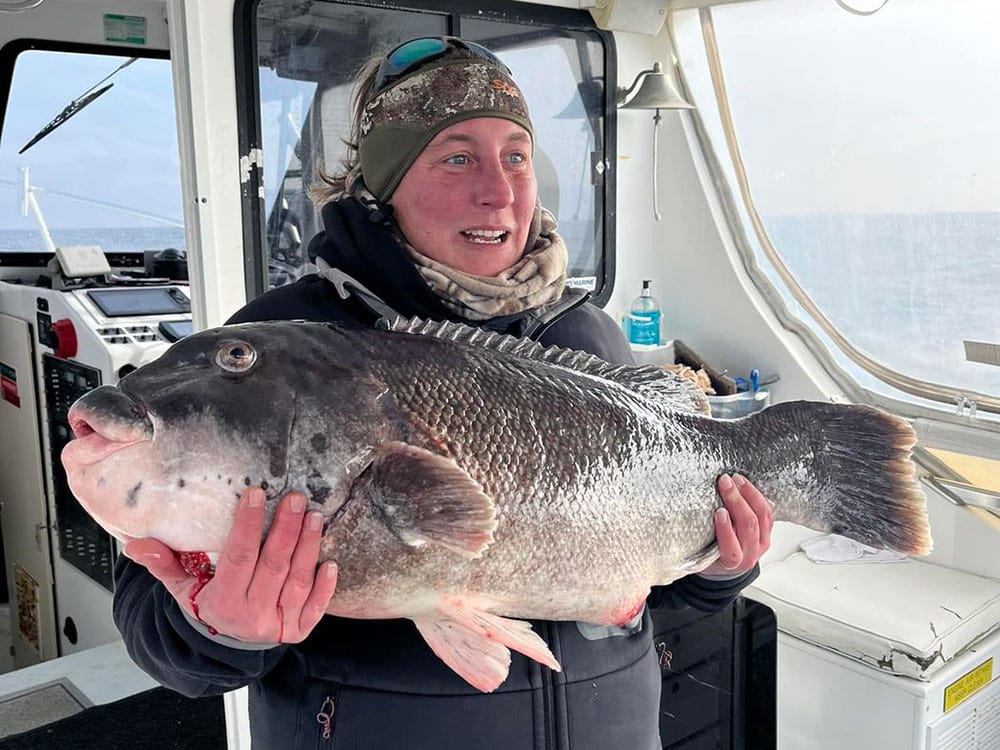
“Patient anglers are prevailing,” reported Capt. Kane Bounds. Bounds fishes out of Ocean City, Maryland, for trophy tautog throughout the winter. Recently, angler Jen Zuppe caught a 23.4-pound tog aboard his boat, the Fish Bound IV. Zuppe’s catch has a great shot to be the next IGFA Women’s World Record in the 30- or 50-pound line class.
Bounds says Zuppe played the game perfectly and was rewarded with a trophy tog. “She had just moved closer to the bow,” Bounds remembered. “While the rest of the crew fished from the stern, Zuppe took her bait rig away from the crowd.”
The record-breaking tautog gave up a good fight, but Zuppe is an accomplished angler who knows how to beat a big fish. “Last year, she caught a 13-pounder with me,” Bounds said.
Have Patience When Tautog Fishing

Bounds says if fishing is slow, he moves the boat several times during a typical trip. Anglers who fish hard and pay attention will be rewarded with trophy blackfish. “Find a little structure, keep the bait on the bottom, don’t move it, and wait,” Bounds recommends.
Fish Bound IV has been fishing 10 to 30 miles offshore, between 60 and 120 feet of water. “If the wind has been blowing — and the wind always seems to blow in the winter — go farther offshore in search of clear water when the wind is more manageable,” Bounds says.
Really windy days keep the boat closer to shore or at the dock.
Even when a tog bites, Bounds warns against acting too quickly. “Quit trying to set the hook prematurely; let the fish eat,” he says. Cold water blackfish move slowly and suspiciously. “I was just fussing at people today about setting the hook too soon,” Bounds laughs.
Tog fishing should remain steady off Mid-Atlantic states, as long as the water temperature is above 42 degrees.
Tautog Fishing Tackle

For tautog tackle, Bounds recommends a medium-heavy rod with a soft tip and considerable backbone. “Most of the anglers are using a Jigging World Night Ranger rod,” Bounds says.
The rod is matched to a conventional reel spooled with 50-pound braided line. “A slower reel, 3:1 to 5:1 retrieve ratio, brings the tog to the surface slowly, improving chances of survival after being released,” Bounds explains.
To the end of the braided line, Bounds adds six feet of 50 pound monofilament for abrasion resistance and stretch. He ties a three-way rig with a 5/0 octopus hook and 6- to 12-ounce bank sinker. “Switch sinkers to match the current,” Bounds suggests. Adding weight as the current increases ensures the bait stays in the structure directly under the boat.
When the current drops, anglers switch to lighter spinning gear and a 2-ounce jig with a short-shank hook. The jig makes it possible to place the bait directly on the bottom, even in heavy structure.
Top Baits for Blackfish
The top bait for Mid-Atlantic anglers is green crabs. “Sometimes the fish want a big crab, sometimes a small one,” Bounds adds. He says blackfish are picky and will prefer a whole crab or half, legs or no legs. “I keep experimenting until I find what works that day,” he says.








